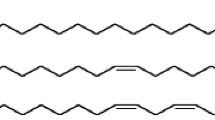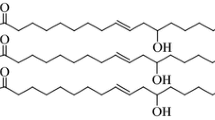Abstract
Growing environmental concerns over the use of mineral oil based lubricants in various fields have led to an increased attention towards the use of environmentally benign bio-lubricants. Working in this direction, the present report describes the synthesis of a homopolymer of almond oil and its copolymers with decyl acrylate. The structures of the prepared polymers were confirmed using FT-IR, NMR, and GPC analysis. Additive performances of each of the prepared polymers as viscosity index improvers and pour point depressants were evaluated by standard ASTM methods. The thermal stability of each of the polymers was investigated. Biodegradability of all the polymers was also tested as per ISO 846:1997 against fungal pathogens. A comparison of their multifunctional performances was also studied and is reported. The copolymers showed better performances as viscosity index improvers and pour point depressants. The thermal stability of the copolymers was also found to be higher than the homopolymer. As expected, the homopolymer showed better biodegradability among the other polymers.
Graphical Abstract









Similar content being viewed by others
References
Li W, Wu Y, Wang X, Liu W (2012) Tribological study of boroncontaining soybean lecithin as environmentally friendly lubricant additive in synthetic base fluids. Tribol Lett 47(3):381–388
Pawlak Z (2003) Tribochemistry of lubricating oils. Elsevier Science, Amsterdam
Florea M, Catrinoiu D, Paul L, Balliu S (1999) The influence of chemical composition on the pour-point depressant properties of methacrylate copolymers used as additives for lubricating oils. Lubr Sci 12:31–44
Nassar AM (2008) The behaviour of polymers as viscosity index improvers. Pet Sci Technol 26:514–522
Ghosh P, Das M, Upadhyay M, Das T, Mandal A (2011) Synthesis and evaluation of acrylate polymers in lubricating oil. J Chem Eng Data 56:3752–3758
Fuchs M (2000) The world lubricants market, current situation and outlook. 12th International Colloquium on Tribology
Betton CI (2010) Lubricants and their environmental impact. In: Mortier RM, Fox MF, Orszulik ST (eds) Chemistry and technology of lubricants. Springer, Dordrecht, pp 435–457
Aluyor EO, Obahiagbon KO, Ori-jesu M (2009) Biodegradation of vegetable oils: a review. Sci Res Essays 4(6):543–548
Santos JCO, Santos IMG, Conceicao MM, Porto SL, Trindade MFS, Souza AG, Prasad S, Fernandes VJ, Araujo AS (2004) Thermoanalytical, kinetic and rheological parameters of commercial edible vegetable oils. J Therm Anal Calorim 75:419–428
Shanta SM, Molina GJ, Soloiu V (2011) Tribological effects of mineral-oil lubricant contamination with biofuels: a pin-on-disk tribometry and wear study. Adv Tribol. https://doi.org/10.1155/2011/820795
Karmakar G, Ghosh P (2013) Green additives for lubricating oils. ACS Sustain Chem Eng 1:1364–1370
Li W, Jiang C, Chao M, Wang X (2014) Natural garlic oil as a high-performance, environmentally friendly, extreme pressure additive in lubricating oils. ACS Sustain Chem Eng 2:798–803
Liu Z, Sharma BK, Erhan SZ, Biswas A, Wang R, Schuman TP (2015) Oxidation and low temperature stability of polymerized soybean oil-based lubricants. Thermochim Acta 601:9–16
Adhvaryu A, Erhan SZ (2002) Epoxidized soybean oil as a potential source of high-temperature lubricants. Ind Crops Prod 15:247–254
Abdallah A, Ahumada MH, Gradzei TM (1998) Oil content and fatty acid composition of almond kernels from different genotypes and california production regions. J Am Soc Hortic Sci 123(6):1029–1033
ASTM (2004) Standard Practice for Calculating Viscosity Index From Kinematic Viscosity at 40 and 100 °C. ASTM Standard D 2270, Annual Book of ASTM Standards. ASTM International, West Conshohocken, PA
Ghosh P, Das T, Nandi D, Karmakar G, Mandal A (2010) Synthesis and characterization of biodegradable polymer: used as a pour point depressant for lubricating oil. Int J Polym Mater 59:1008–1017
Chandure AS, Umare SS (2007) Synthesis, characterization and biodegradation study of low molecular weight polyesters. Int J Polym Mater 56:339–353
Ghosh P, Karmakar G (2014) Evaluation of sunflower oil as a multifunctional lubricating oil additive. Int J Ind Chem 5:7
Liu M, Huang Z, Yang Y (2010) Analysis of biodegradability of three biodegradable mulching films. J Polym Environ 18:148–154
Lu Y, Larock RC (2009) Novel polymeric materials from vegetable oils and vinyl monomers: preparation, properties, and applications. ChemSusChem 2:136–147
Abdel-Azim A, Huglin MB (1983) Selective solvation of polystyrene in tetralin/cyclohexane mixtures. Polymer 24:1308–1312
Han S, Wang P, Wang YH, Song YP, Ren TH (2010) Impact of alkyl methacrylate–maleic anhydride–alkyl methacrylate terpolymers as cold flow improver on crystallization behaviour of diesel fuel. Process Saf Environ Prot 88:41–46
Chen WH, Zhao ZC, Yin CY (2010) The interaction of waxes with pour point depressants. Fuel 89:1127–1132
Agaev SG, Kalinina IG (1990) Use of pour-point depressants in production of low-pour residual oils. Chem Technol Fuels Oils 26:174–176
Kuzmić AE, Radošević M, Bogdanić G, Sricá V, Vuković R (2008) Studies on the influence of long chain acrylic esters polymers with polar monomers as crude oil flow improver additives. Fuel 87:2943–2950
Funding
The authors are thankful to UGC, New Delhi, for financial support. Thanks are also due to the Indian Oil Corporation Ltd., (India) for providing the base oils.
Author information
Authors and Affiliations
Corresponding author
Ethics declarations
Conflict of interest
The authors declare that they have no conflict of interest.
Electronic supplementary material
Below is the link to the electronic supplementary material.
Rights and permissions
About this article
Cite this article
Saha, D.K., Ghosh, P. Almond Oil as Potential Biodegradable Lube Oil Additive: A Green Alternative. J Polym Environ 26, 2392–2400 (2018). https://doi.org/10.1007/s10924-017-1135-x
Published:
Issue Date:
DOI: https://doi.org/10.1007/s10924-017-1135-x




